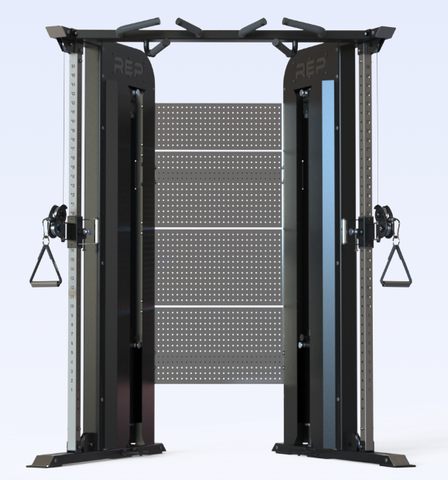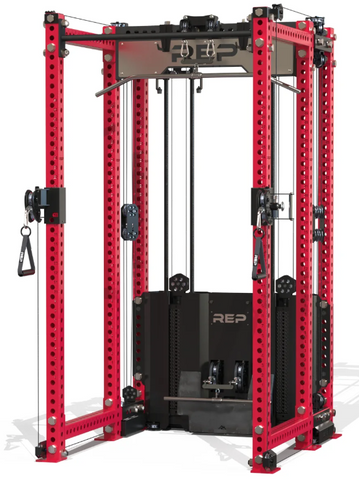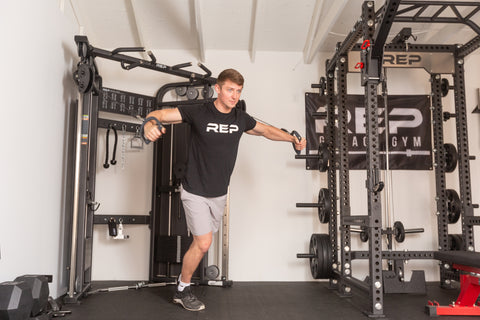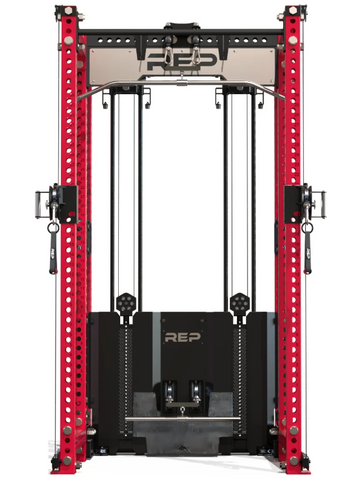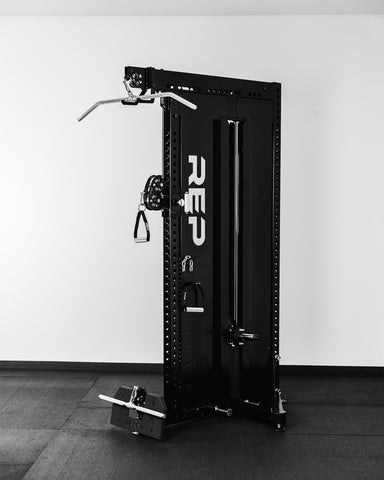
Not sure which cable machine is the best match for you? Here’s how they compare.
While there’s a certain kind of joy in feeling a cold barbell in your hands, there’s also a special place in a lifter’s heart for that burn of a cable machine.
A cable machine (also called a functional trainer or pulley machine) creates resistance using weights (plates or stacks) attached to a cable running through a pulley system.
REP offers several different functional trainers. Some are stand-alone, while others attach to your power rack, but they’re all glorious in their own ways. Not sure which is the best match for you? Here’s how they compare.
Benefits of Cable Machines
Cables provide a different stimulus than free weights (dumbbells and barbells). They provide constant tension on the muscles when lifting and lowering the weight -- and tension is related to strength and muscle growth. Cables also allow you to easily work muscles through different planes of motion and angles.
Here are some other benefits of a functional trainer:
- Cable exercises can be easier to perform correctly than barbell exercises, which can make them safer.
- They’re great for lifters of all levels.
- They’re super versatile for just about every muscle group.
- You can isolate muscle groups easily on cable machines.
-
Selectorized machines (with weight stacks and pins) are quick to load and adjust, speeding up your workout. It’s also easy to swap out handles for different purposes.
What is a functional trainer? Read about them here.
Types of Cable Machines
There are several different types of cable machines.
Selectorized vs. plate-loaded: Selectorized machines use pre-set stacks of weight, adjusted by pins you stick into a hole in the plate. Plate-loaded trainers have a weight horn (or multiple weight horns) attached to the cable, and you load weight plates onto the horns to change the weight. To add weight to a plate-loaded functional trainer, you need to have separate plates.
Ratio: A 1:1 ratio means 20 pounds on the cable creates 20 pounds of resistance for you to move. These are also called single-pulley machines. A 2:1 ratio means 20 pounds feels like 10 pounds. These are also called double-pulley machines. A 2:1 ratio is great for functional training, when you want a faster-traveling cable. Don’t mistake two single-pulley machines for a double-pulley; the resistance you will feel is different. Read more about cable ratios and why they're important here.
Dual pulley vs. single pulley: A dual pulley cable machine allows for independent movement of each side, providing more versatility and requiring more stabilization, while a single pulley cable machine links both handles together, meaning the movement on one side directly affects the other, often leading to a more uniform movement pattern.
Dual weight stack vs. single weight stack: A dual weight stack means the cable machine has two separate weight stacks. A single weight stack means there is just one stack. A dual stack setup is particularly versatile and effective for both individual and shared use in a variety of exercise routines. Read more about the benefits of a dual stack functional trainer here.
Specialty cable machines: In addition to the standard cable machines, you can find two specialty types designed to target the back (although you can use them in other ways, too). These are the lat pulldown (pulley is up high) and seated row machines (pulley is low to the ground). The height of these pulleys is not adjustable.
How to Choose a Functional Trainer?
Unsure how to pick the right functional trainer for your home gym and personal goals? Let us make it easy for you.
Here’s a quick look at the pros and cons of REP’s different functional trainer options.
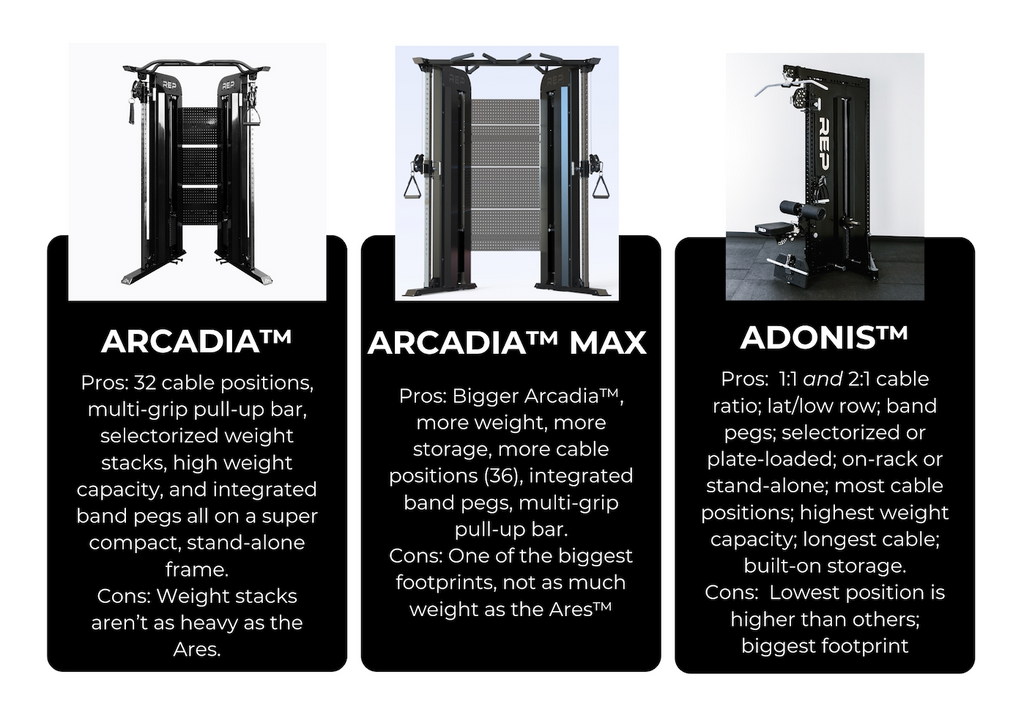
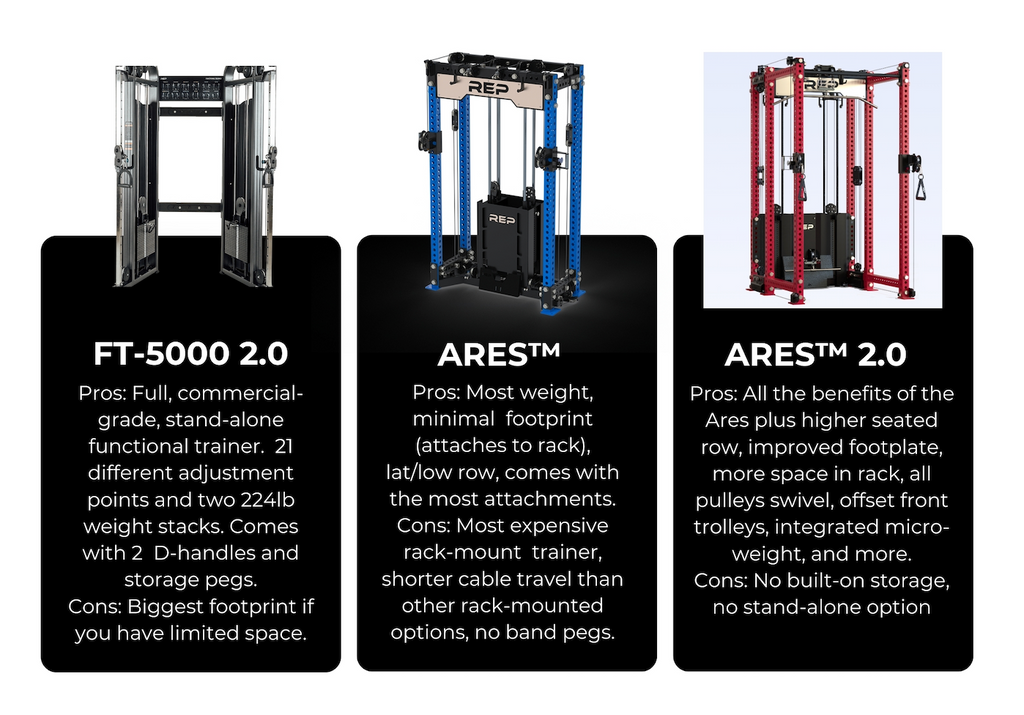
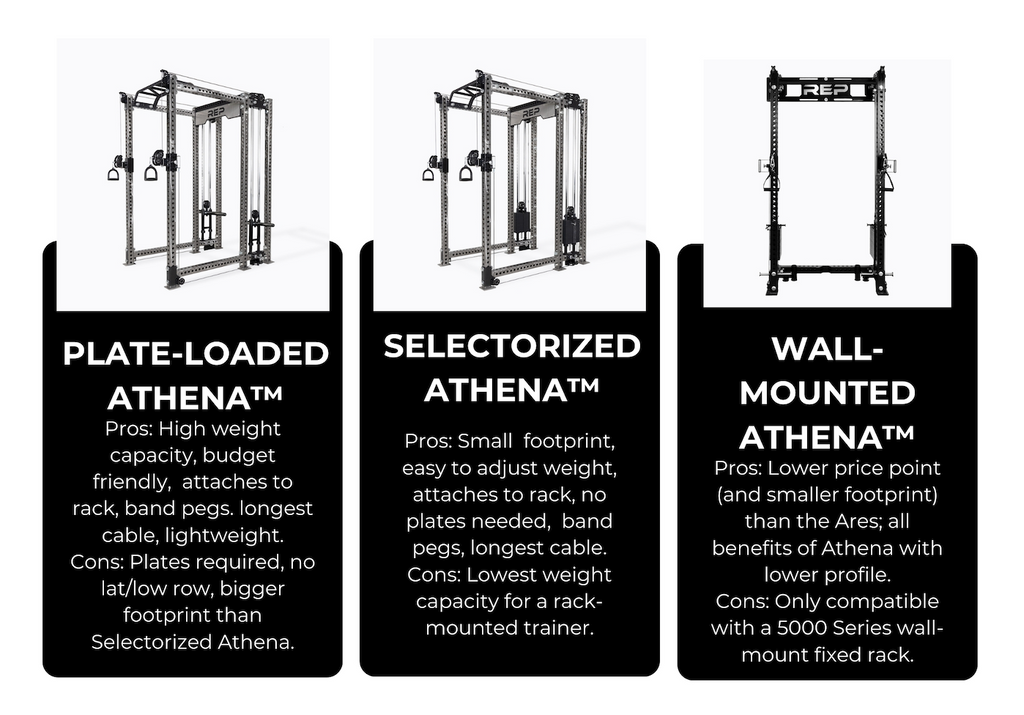
Here's a closer look at those pros and cons.
Arcadia™ Functional Trainer
Pros: 32 cable positions, multi-grip pull-up bar, selectorized weight stacks, high weight capacity, and integrated band pegs all on a super compact, stand-alone frame.
Cons: Weight stacks aren’t as heavy as the other stand-alone functional trainers.
Arcadia™ Max Functional Trainer
Pros: Best, full-sized, stand-alone, commercial grade functional trainer. Bigger Arcadia™ functional trainer, more weight, more storage, more cable positions (36), band pegs, multi-grip pull-up bar.
Cons: One of the biggest footprints (a con if you have limited space), no lat pulldown/low row feature.
Adonis™ Cable Tower
Pros: Both 1:1 and 2:1 cable ratio; built-on lat pulldown/low row and trolley; highest weight capacity; built-on storage and band pegs so you can use resistance bands; selectorized or plate-loaded options; on-rack or stand-alone; most cable positions; longest cable travel; and compatible with modular storage, seat attachment, and 5000 Series attachments.
Cons: Lowest cable position is higher than others, which may be a downside for very short lifters wanting to do exercises like bicep curls -- but it can be more comfortable for seated rows. Only one weight stack per Adonis™ cable tower, so if you want dual stacks, you have to get two.
FT-5000 2.0
Pros: Full, commercial-grade, stand-alone functional trainer. Features 21 different adjustment point and comes with two polymer D-handles and storage pegs to organize your attachments.
Cons: Biggest footprint if you have limited space.
Ares™ Cable Machine
Pros: Biggest weight capacity, minimal additional footprint, integrated lat pulldown/low row, comes with the most attachments.
Cons: The most expensive rack-mount functional trainer, shorter cable travel than other rack-mounted options, no band pegs for resistance bands.
Ares™ 2.0 Cable Machine
Pros: All the benefits of the Ares™ cable machine plus higher seated row (and lat pulldown functionality when paired with the 2 to 1 Cable Connector), improved footplate, more space in rack, all pulleys swivel, offset front trolleys, integrated micro-weights, and more.
Cons: No built-on storage, no stand-alone option, no integrated band pegs.
Plate-Loaded Athena™ Cable Machine
Pros: High weight capacity, budget friendly (assuming you already have plates), integrated band pegs (so you can use resistance bands), Athena™ cable machine has the longest cable travel length of all functional trainers. The attachment itself is lightweight, baby (87lbs per unit).
Cons: You need to own plates to add resistance, lat/low row feature not included (you must buy this separately), bigger footprint than Selectorized Athena™ attachment.
Selectorized Athena™ Cable Machine
Pros: Small additional footprint, easy to adjust weight, no plates needed, integrated band pegs, the Athena™ cable machine has the longest cable travel length of all functional trainers.
Cons: Lowest weight capacity for a rack-mounted functional trainer (but it does match the capacity of the FT-5000).
Wall-Mounted Athena™ Cable Machine
Pros: Lower price point (and smaller footprint) than the Ares™ attachment.
Cons: Only compatible with a 5000 Series wall-mount fixed rack.
Still Can’t Decide?
Here are some of the reasons you might select one functional trainer over the other.
If you have limited space and no power rack: Arcadia™ functional trainer
The brings high-end features to a compact functional trainer. Invert the Multi-Grip Pull-Up Bar and this functional trainer is only 78" tall. The front is 55.3" wide, tapering back to just 24" -- and 35.8" deep throughout. Yet it packs a big punch, with 170lbs of weight on each side (with a 2:1 ratio) and a whopping 32 different height options.
If you have limited space and a power rack: Ares™ 2.0 cable attachment
The Ares™ 2.0 attachment mounts to your existing power rack. In total, it doesn't add much of a footprint to the PR-5000.
If you have limited space, a limited budget, and a power rack: Plate-Loaded Athena™ cable attachment
The Plate-Loaded Athena™ cable machine attaches to the side of your power rack, so it doesn’t add much of a footprint to your gym, but it’s more affordable than the Ares™ cable machine or Selectorized Athena™ attachment – assuming you already have plates. Also, a lat and low row attachment isn’t included in the Athena™ cable machine, so it’s a good bet if you already have one, don’t want one, or don’t mind buying one separately.
If you have limited space and don’t have a large collection of plates: Selectorized Athena™ attachment
The Selectorized Athena™ attachment adds less width to your power rack than the Plate-Loaded Athena™ attachment, and with a built-on weight stack, you don’t need to own (or store) plates to add weight to the cables. It does have a slightly bigger footprint than the Ares™ cable machine, which is also selectorized. However, if you don’t want/need an integrated lat and low row attachment (or already have one/don’t mind buying one separately), you’ll want to go with the Athena™ cable attachment.
If you want a functional trainer attachment with a lat pulldown/low row attachment: Ares™ 2.0 cable machine or Adonis™ cable tower
The Ares™ 2.0 cable machine and Adonis™ cable tower are the only functional trainers you can attach to your power rack that also come with a lat pulldown and low row feature.
If you want a stand-alone cable system: FT-5000 2.0
If you have space for a full, stand-alone cable system that’s tough enough for a commercial gym, the FT-5000 2.0 is the mother of all. It boasts the highest weight capacity for a stand-alone functional trainer.
Note: If you choose to build the stand-alone dual-sided Adonis™ cable tower, its weight capacity is even higher – since the lat pulldown and low row feature has a 1:1 cable ratio, so what you load up is the actual resistance you feel.
If you want the best commercial-grade, stand-alone functional trainer with the highest weight capacity: Arcadia™ max functional trainer
The Arcadia™ max trainer’s selectorized weight stacks can be upgraded all the way to 540lbs (at a 2:1 ratio). The max has a ton of premium features and was designed in house. It's the best of the best of the best.
If you need the most weight: Ares™ attachment or Ares™ 2.0 attachment
If you really need to load up the weights for the gains, the Ares™ attachment and the 2.0 version have the other machines beat in terms of weight capacity. This attachment can handle 620lbs between both sides (feels like 310lbs).
If you want both a 1:1 and 2:1 cable ratio: Adonis™ cable tower
The Adonis™ cable tower uniquely has both a 1:1 cable ratio and a 2:1 ratio. The lat pulldown and low row feature uses the 1:1 ratio, where 20lbs feels like 20lbs, ideal for slower, strength-focused exercises. The trolley uses the 2:1 cable ratio, where 20lbs feels like 10lbs, best for quicker, functional-style training.
If you want a full-sized stand-alone functional trainer that’s super versatile in various ways: Arcadia™ max functional trainer
The Arcadia™ max functional trainer has the most cable positions of any trainer (36) and comes with four built-on pegboards for easy storage.
The Specs
FT-5000 2.0 Functional Trainer

Stand-alone? Yes.
Footprint: 85.5"(H)x58” (front width)x36”(D) or 7.1'x4.8'x3'
Ratio: 2:1
Max capacity: Dual weight stacks. Each tops out at 224lbs, for a total of 448lbs (feels like 224lbs).
Cable positions: 21
Cable travel: 86” (7.2')
Comes with: Two polymer D-handles, storage pegs, and an exercise placard
Weight of product: 1,001lbs
Other features: Multiple pull-up grips
More info here.
Ares™ cable machine
Stand-alone? No. It attaches to your PR-4000 or PR-5000 power rack.
Footprint: Adds 1.2”(H)x1.6”(W)x6”(D) to the PR-4000. Adds 1.2”(H)x5”(W)x6” (D) to the PR-5000.
Ratio: 2:1
Max capacity: Each weight stack is 260lbs (feels like 130lbs) with an option to upgrade to 310lbs (feels like 155lbs) per stack, for a total of 620lbs (feels like 310lbs). The trolley and cable capacity per side are 450lbs (feels like 225lbs), if you want to add bands and other forms of resistance beyond the stack.
Cable positions: Front pulleys swivel 180 degrees for versatile movements and to work outside the rack. The trolley uses the existing holes on the power rack, so there are a lot of positions and they’re in 2” increments (25-35 cable positions).
Cable travel: 96” (8’) for the 93” rack or 72” (6’) for the 80” rack.
Comes with: Footplate, four micro 2.5lb weights, rubber grip strap-style handle, a knurled chrome lat pulldown bar and low row bar, and a connector banana.
Weight of product: 965lbs
Other features: Integrated lat pulldown and low row attachment.
More info here.
Ares™ 2.0 cable machine
Stand-alone? No. It affixes to your existed PR-4000 or PR-5000 power rack.
Footprint: What it adds depends on the exact configuration, but the max footprint it would add to your rack is 1.6”x5.2”x0.6” -- very minimal.
Ratio: 2:1 cable ratio
Max capacity: 620lbs with the upgrades (feels like 310lbs)
Cable positions: The trolley uses the existing holes on the power rack, so there are a lot of positions and they’re in 2” increments (25-35 cable positions).
Cable travel: 6’-8’, depending on the configuration.
Comes with: Lat pulldown, connector, and 2 D-handles.
Other features: Lat and low row feature, integrated drop-down micro-weights, a larger footplate that’s angled for support, a higher seated row so you can use it on a bench or on the floor, depending on your preference.
More info here.
Plate-Loaded Athena™ attachment
Stand-alone? No, it mounts to the side of your PR-4000 or PR-5000 rack.
Footprint: Adds 1.8”(H)x12.3”(W)x7.9”(D)
Ratio: 2:1
Max capacity: 540lbs (feels like 270lbs)
Cable positions: Front pulleys have 180-degree swivel for versatility when working outside the rack. The trolley uses the existing holes on the power rack, so there are a lot of positions and they’re in 2” increments (25-35 cable positions).
Cable travel: 106” (8.8’) for the 93” rack or 82.8” (6.9’) for the 80” rack
Comes with: Rubber grip strap-style handle
Weight of product: 87lbs per unit
Other features: Integrated band pegs on the base and headplate
More info here.
Selectorized Athena™ attachment
Stand-alone? No, it mounts to the side of your PR-4000 or PR-5000 rack.
Footprint: Adds 1.8”(H)x3.7”(W)x7.9”(D) to the PR-4000 or 1.8”(H)x5”(W)x7.9”(D) to the PR-5000.
Ratio: 2:1
Max capacity: 220lbs (feels like 110lbs) per side, or 440lbs total (feels like 220lbs).
Cable positions: Front pulleys have 180-degree swivel for versatility when working outside the rack. The trolley uses the existing holes on the power rack, so there are a lot of positions and they’re in 2” increments (25-35 cable positions).
Cable travel: 106” (8.8’) for the 93” rack or 82.8” (6.9’) for the 80” rack
Comes with: Rubber grip strap-style handle
Weight of product: 258lbs per unit
Other features: Integrated band pegs on the base and headplate
More info here.
Wall-Mounted Athena™ attachment
Stand-alone? No
Footprint: 81.2"/94.2"x58.2"x27.6" or 6.8'/7.9'x4.9'x2.3'
Ratio: 2:1
Max capacity: 440lbs (feels like 220lbs) with upgrade
Cable positions: About 25 (uses upright holes)
Cable travel: 6.9' or 8.8' (depending on rack)
Comes with: Band pegs, 1 D-handle
Other features: Integrates into a 5000 Series wall-mount fixed rack
More info here.
Arcadia™ functional trainer
Stand-alone? Yes
Footprint: 80.9"x55.3"x24" (can reduce height to 78" by inverting multi-grip pull-up bar) or 6.7'x4.6'x2'
Ratio: 2:1
Max capacity: 340lbs (feels like 170lbs)
Cable positions: 32
Cable travel: 6.75’
Comes with: 3 pegboards, 2 D-handles
Other features: High-end features
More info here.
Arcadia™ max functional trainer
Stand-alone? Yes
Footprint: 7.3'x2.7'-6.2'x3.6'
Ratio: 2:1
Max capacity: 540lbs with upgrades
Cable positions: 36
Cable travel: TBD
Comes with: Two D-handles, four pegboards for storage of small items
Other features: Make small jumps with an integrated, selectorized 5lb plate; no separate micro-plates that can be misplaced, especially in commercial gyms.
More info here.
Adonis™ cable tower
Stand-alone? Can be stand-alone (with optional support legs) or mounted off to the side of a 4000 or 5000 Series power rack or rig.
Footprint: 92.3”(H)x54.9”(D)x45.5”(W) with base or 44.4” without base, or about 7.8’(H)x4.75’(D)x~3.75’(W) -- about 132.8’ footprint (HxDxW).
Ratio: Both 1:1 and 2:1
Max capacity: 450lbs
Cable positions: 34
Cable travel: 9’ for the trolley and 4.5’ for the lat pulldown and low row attachment
Comes with: D-handle, lat pulldown bar, low row bar, and pegboard for storage of small items.
Other features: Uniquely designed add-on weights; can choose a single or dual unit; telescoping footplate allows for seven adjustment angles; compatible with 5000 Series attachments.
More info here.
Learn More About Cable Machines
- Want to maximize your cable workouts? Check out “What Are All the Different Cable Grip Attachments and How to Use Them?”
- Here’s a video comparing the Ares™ cable machine vs. Athena™ attachment (with a Lat and Low Row Attachment).

NEWSLETTER SIGNUP
Product launch information, promotions, blogs, and REP news.









